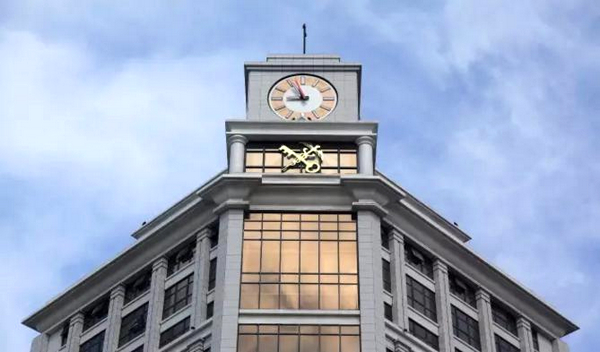The Haicang customs house clock town: Internationalizing tone of Xiamen

The clock tower stationed on top of the Haicang customs house
At 9 o’clock on Aug. 11, the clock tower stationed on top of the Haicang customs house ticked for the first time, accompanied by the melodies of the song Waves on Gulangyu Island. The clock chimes different melodies three times every day.
The clock tower in Haicang, a peninsula on the western coast of Xiamen, is the 15th Chinese customs house clock tower which chimes. It serves as a vocal symbol for Haicang’s development into an international first-class bay. According to Liu Yangwu, head of the Haicang customs house, the clock chimes three different melodies a day: at 8 o’clock in the morning, it is The East Is Red; at 12 o’clock in the noon, it chimes The Westminster Quarters; and at 6 o’clock in the afternoon, it chimes Waves on Gulangyu Island.
A Ukrainian man, who has worked in Haicang for five years, was invited to the ceremony commemorating the first tick of the clock. He told the reporter that the clock tower will become a landmark building in Haicang. “Haicang is developing faster and faster, and becoming more and more beautiful. It’s quite an honor and a privilege to work here,” he said.
With a height of 20.5 meters, the clock tower is adjacent to Songgu Wharf and just across the water from the ferry terminal on the peninsula. Standing 1.8 kilometers from the Gulangyu Island, visitors to the area are almost certain to pass by. This means that many people coming to Gulangyu from all around the world can hear the chimes.
The practice of the clock tower at customs houses to chime originated in the era when the timer was underdeveloped. It used to serve as a reference for ships to calibrate time, which was conducive to management and safety of navigation. These days it symbolizes the prosperity of a harbor.
Since Haicang established the customs agency in December, 1999, it developed quickly and has become a hub of land and sea transportation in southeastern China and an important container port. It has now opened 29 sea lanes serving the foreign trade with 203 countries and regions. Its average industrial output value per person, fiscal revenue and foreign trade volume rank at the forefront in Fujian Province. It also has fostered favorable environment for business and trade. Cherishing an international vision and thinking, Haicang is endeavoring to become a world-leading port.
